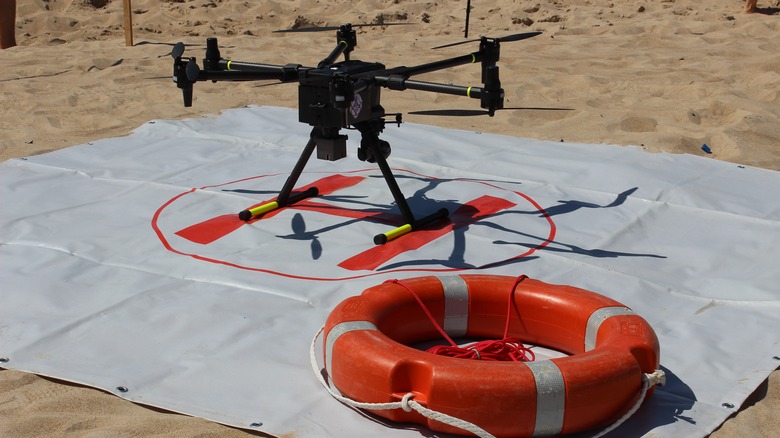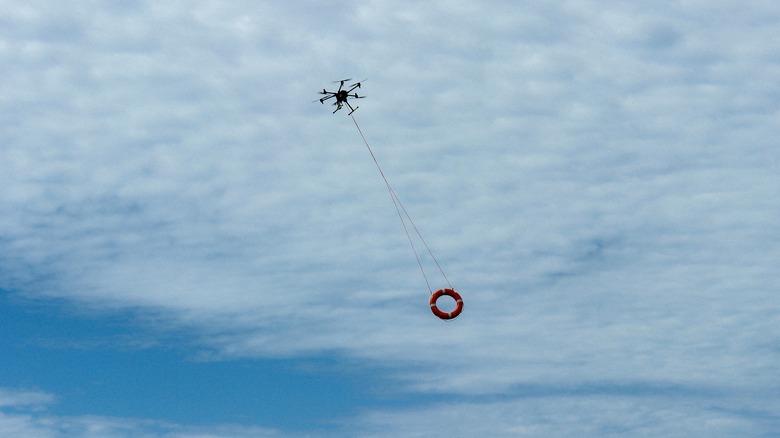Here's One Way New York City's Fire Department Is Using Drones To Save Lives
Drones have a reputation for being fearsome weapons. For the U.S. Army, there's a concern that there may be too many drones in the battlefield space, and this can have the unfortunate effect of complicating operations. Unfriendly drones, meanwhile, are an ever-present threat that can be difficult to detect and counter, with cheap military drones becoming the scourge of even mighty tanks. The asset that made UAV technology such a potent force in modern-day conflict is its utility and versatility. Because of this, drones are being used in a wide range of fields outside of war zones.
For some, they are weapons, for hobbyists, they are a fun and exhilarating distraction, and for firefighters, they can be an invaluable life-saving tool. A primary advantage of a drone is its ability to move quickly and precisely, potentially ready to respond to an emergency situation in which every second counts. This is exactly what happened with the New York City Fire Department in October 2025.
ABC 7 New York reports that the fire department discovered somebody in distress in the East River, around the Queensboro Bridge. Divers were dispatched to rescue them from the waters, but not before an FDNY drone first located the person. Just as with military drones, it's the high vantage points they provide that's unrivaled, and this is an increasingly critical part of rescue operations such as this one, too.
The fire department's drones help keep the waters of New York safe
Drones, depending on the intended use and model, can be incredibly cost-effective, making them significantly advantageous. In October 2023, the FDNY started trialing a new program with which to provide quick and effective aid to those who find themselves out of their depth or otherwise in danger in the waters of the state. This can be an ever-present danger in New York, where formidable rip currents can be unpredictable, endangering even the most confident of swimmers. The drones had originally been intended to monitor a very different threat (sharks), but it was soon evident that New Yorkers were more often at threat from the unpredictable currents.
Drones armed with floatation devices were seen as a quick-to-deploy solution to get struggling swimmers the support they needed as quickly as possible. Captain Michael Leo of the robotics team at FDNY (via Government Technology) said, "We changed the name of our mission to life safety overwatch almost right away." It's a particularly apt name for a service that revolves around drones patrolling and seeking out those in distress. When they detect such a target, their secret weapon can be deployed: A device that inflates instantaneously when it hits the water, thereby helping the person in question to stabilize themselves while also serving as a sort of colorful beacon to further highlight their position.
Drones are engaged in life-saving efforts around the world
In the October 2025 rescue, drones deployed colorful buoys into the water for boats to easily find the swimmer. The FDNY is far from the only rescue team to utilize this concept, though, and there's so much more that drones can offer water rescue objectives. Their sensors, for instance, allow for beneficial functionality like thermal imaging. In water rescues, time is against the subject, and a delay in locating them because it's dark could mean the worst possible outcome. Australia is another nation that operates a similar scheme.
In Queensland, DJI M3OT drones are used not only to monitor for swimmers in distress and provide their locations to rescue teams, but also to help prevent shark attacks. DJI Enterprise notes, "The high-resolution zoom and wide-angle cameras of M30T make it easy to detect movement in the water." Drones perform a sweep of popular areas around every 45 minutes, in an initiative operated by Surf Life Saving Queensland (SLSQ).
SLSQ equips its M350RTK drone with a drop kit that can carry multiple loads (up to 40 kg in total). Its functionality is key in dispensing rescue equipment like floatation vests directly into the water where they're needed. Ultimately, drones are fast, adaptable, and help ensure that resources are deployed where they're needed most. There's sure to be more they can do in the future, too, as AI is enhancing military drones, and some of these benefits are sure to extend to those used in other fields.


